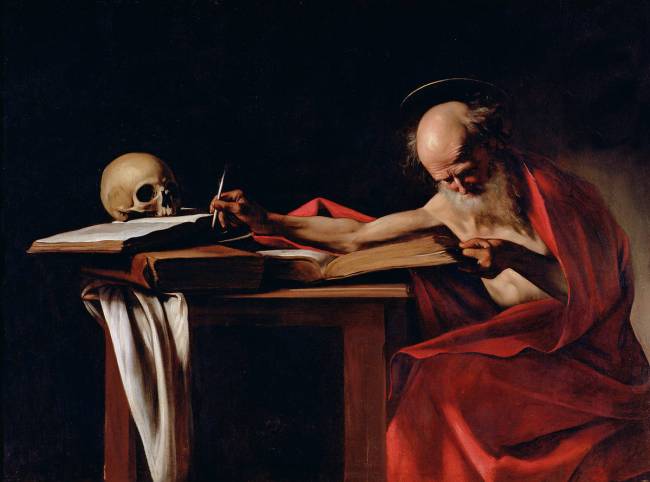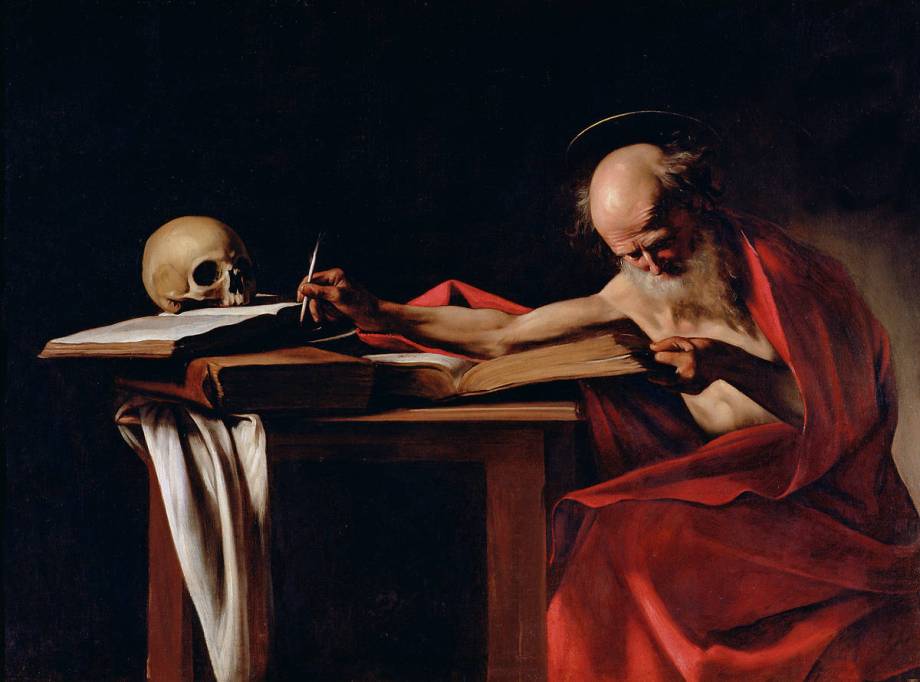Shop art print and framed art St Jerome writing by Caravaggio
Customise
Your art print
St Jerome writing OF Caravaggio
St Jerome writing
Saint Jerome writing by Le Caravaggio: an iconic work
When it comes to the famous Italian painter Le Caravaggio, the work Saint Jerome Writing never fails to be mentioned.Dated between 1605 and 1606, this canvas is now housed in the prestigious Galerie Borghese in Rome, Italy.Rich in history and detail, Saint Jerome Writing is a masterpiece that testifies to Caravaggio's talent and his major contribution to art history.
The story of Saint Jerome writing
Painted during Caravaggio's Roman period, Saint Jerome Writing is also sometimes called Saint Jerome at Study.The painting depicts a scene from the life of Saint Jerome, a Doctor of the Christian Church who lived in the 4th century A.D. He was notably known for translating the Bible into Latin, thus giving rise to the Vulgate, the official version of the Catholic Church for several centuries.
This work was commissioned by Cardinal Scipione Borghese, who was passionate about art and wanted to build a prestigious collection.The choice of Saint Jerome was not insignificant, as this illustrious figure represented the ideals of the cardinal, who wished to promote the reform of the Church and defend its spiritual heritage.
This work was commissioned by Cardinal Scipione Borghese, who was passionate about art and wished to build up a prestigious collection.
Description
Saint Jerome Writing is a generously sized canvas, 112 x 157 cm.It is distinguished by its realistic depiction and the dramatic staging so characteristic of Caravaggio's style.The first glance at this painting plunges the viewer into a dark space, contrasting with the intense luminosity that seems to radiate from the main figure. The saint is depicted wearing a red drapery, crowned with a fine halo, seated at his work table. Books are open in front of him to help him in his task.A human skull with black eye sockets, resting on the books, seems to be observing the translator's hand.
Caravaggio's chiaroscuro
The Italian painter was famous for his clair-obscur technique, also known as tenebrism. This method involves creating sharp contrasts between illuminated areas and those plunged into shadow, in order to emphasize depth and volumes.
Saint Jerome writing is no exception to this rule: here, the light seems to come from above, on the left of the painting, and highlights the figure of the saint as well as his objects of study. The shadowed areas are treated with intense black, creating a theatrical and dramatic effect.
The composition and pictorial elements
The figure of Saint Jerome is depicted seated at a table, concentrating on his translation of the Bible. His desk, in the foreground, is laden with books, quills and other writing implements. The viewer can thus imagine the scholar in his studious activity.
Lying on top of an open book is the famous skull often associated with him, a symbol of vanity and the passage of time. This macabre object is a reminder that the old man is destined for imminent death, while his translation is promised eternity. So, to make this moment of study sacred, the artist chose not to depict the lion, Saint Jerome's faithful companion. This iconographic freedom allows Caravaggio to create an effective composition, showcasing the old man's erudition and sanctity.
The role of this work in the artist's career
Saint Jerome Writing occupies a special place in Le Caravaggio's oeuvre. It was during his Roman period that the painter would truly revolutionize the history of painting with his chiaroscuro technique and acute sense of mise-en-scene. This canvas is a striking testimony to this and a brilliant example.
An expression of Caravaggio's spirituality
Although best known for his secular and sometimes scandalous canvases, Caravaggio produced many religious paintings during his career. Among these, Saint Jerome Writing demonstrates the painter's ability to express the piety and fervor of the figures he depicts.
This portrait of Saint Jerome evokes the character's humility before God and his tireless search for divine truth. In this, the work is an example of Caravaggio's talent for conveying emotions and a sense of spirituality.
A major influence on artists of the time
Caravaggio's innovative style had a major influence on later Baroque and Caravaggesque painters. Caravaggio's bold use of chiaroscuro and dramatic staging were elements that were to be taken up by many artists, such as Rembrandt or Georges de La Tour.
This artwork is a painting from the classical period. It belongs to the baroque style.
« St Jerome writing » is kept at Galleria Borghese, Rome, Italy.
Find the full description of St Jerome writing by Caravaggio on Wikipedia.



































